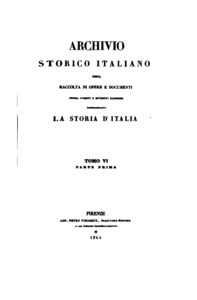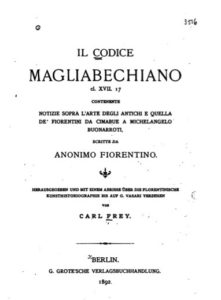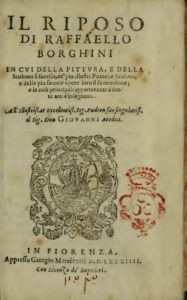Sevillan Don Fadrique Enríquez de Ribera was Marquis of Tarifa, Governor of Andalusia, Lord of Bornos, as well as proprietor of Ribera and Alcalá de los Gazules. His socio-political position among the Andalusian elite was thanks to his descent from an old Castilian line, his marriage to Beatriz and later Catalina Ribera, and his kinship with the new Catholic crown. In 1518, he undertook a pilgrimage to Jerusalem. Since journeys of this sort involved certain risks, they were not a typical undertaking for Spanish nobles of the era. Thus, it must have been a journey of particular significance. While the marquis’s motives for the journey cannot be known with certainty, his travel manuscript reveals not only his religious interests but also an urge to explore and to educate. On his way back from Jerusalem, he visited various cities in Italy; among them was the city of Pisa. We focus on the passages in which he discusses the sights of Pisa. Don Fadrique Enríquez de Ribera makes a connection between the Camposanto and the Akeldama, a Christian pilgrimage cemetery in Jerusalem.[1] / AK
[1] Manuel González Jiménez: Biografía de Don Fadrique Enríquez de Ribera, in: Paisajes de la tierra prometida. El viaje a Jerusalén de Don Fadrique Enríquez de Ribera, ed. Pedro García Martín, Carlos Martínez Shaw, Manuel González Jiménez, Vicente Lleo Cañal, Viçenc Beltran und Ma del Carmen Álvarez Márquez, Madrid 2001, 79–98.
Source: Published Manuscript, Madrid, Biblioteca Nacional de España, Manuscrito Fadriqueño, ms. 9355, fol. 97r-98r, 236r-240r.
Edition: García Martín 2001: Pedro García Martín (Ed.), Paisajes de la Tierra Prometida. El Viaje a Jerusalén de Don Fadrique Enriquéz de Ribera, Madrid 2001.
Transcription
“Este día, lunes en la tarde, ocho de agosto, fuemos a visitar las estaciones siguientes, que están fuera y cerca de Jerusalén:
Primeramente el Campo de la Sangre, que llaman Archidemac, que fue comprado por los treynta dineros, que es vna cassa cerrada con tres paredes arrimadas a vna peña, que tiene nueue bocas como silos y quando algunas de las naciones de christianos mueren métenlos allí dentro con vn cordel. Tiene de hondura siete estados, poco más o menos, y de largo, con la gordura de las paredes, veynte y quatro varas de medir y de ancho diez y siete con la gordura de las paredes, esto está enfrente del Monesterio de Monte Sión. Dizen que estas paredes hizieron los pisanos quando señorearon esta tierra, y aquí encima bien alto está vna casa que llaman del Mal Consejo, adonde los judíos salieron a concertar con Judas la prisión de Nuestro Señor y lo que le avían de dar. Nos subimos arriba a vella y tanbién la vi desde la huerta del Monasterio de Monte Sión, adonde el Guardián me mostró vna çarça como la de Moysén, que la raýz truxeron de allá.
Más abaxo de Archidimac visitamos la cueua de Sant Pedro, en que acabó de hazer su penitencia, porque aquí abajo va el Valle de Siloé. Más abaxo vn poco desta ladera hazia Val de Siloé está una cueua con muchos apartamientos e vnos poyos en entrando, adonde dizen que los apóstoles se escondieron quando la Passión.” (97v-98v).
“Quatro millas atrás está vn lugar de adonde hera Juan Vocacio que se llama [espacio en blanco] que es tierra de Florencia. Otro día, jueues, venimos a Puterol a comer y a Pissa a cenar, veynte e ocho millas.
Solía ser antes esta ciudad vna de las señorías principales de Ytalia y que vn tiempo señoreó a Ierusalén, que oy día está allí vna fortaleza que llaman Castil de Pisanos, y todo lo demás en que se occuparon en señorear fue en Verbería y en yslas. Armauan ciento e sesenta galeas y las ciento del cuerpo de la ciudad. Estauan tan proueýdos que al toque de vna trompeta cada vno venía con su aperejo. Tenían por costumbre que si los nauíos que pasauan por Liorna, que es el puerto de aquella ciudad, no la saludauan, de echallos a fondo. E vna vez yendo ciertos navíos de personas ecclesiásticas embiadas por el Papa a Jerusalén a suplicación dellas para administrar los sacramentos, porque no saludaron a Liorna tiraron el artillería echáronlos a fondo, y por esto los descomulgó el Papa, que fuesen sieruos de sus sieruos.” (235v-236v).
Lo qual, después de mucho tiempo, absoluió por engaño que hizieron en cierta moneda de oro e plata, en que la vna parte pusieron a Nuestra Señora con su Hijo e en la otra vna cruz, de lo qual mostró vno mucha cantidad della al Papa y como la vio dixo que fuese bendicta la tierra adonde se hizo y dixéronle como hera de Pissa y retificolo, después cumpliose bien lo que dixo porque Florencia y Sena heran sus tributarias y Luca tenía cargo de barrer las calles de Pissa cada sábado.” (236v-237r).
En la misma ciudad se parece lo que fue, avnque está muy destruyda; tiene el mejor sitio que ninguna ciudad e Ytalia; tiene hazia la parte de Sena muy grandíssima campiña y hazia Liorna quinze millas de llano hasta junto a la mar e a vn río que passa por medio que va a dar a la mar; hazia la parte de Luca tiene mucha arboleda y montaña; tiene vna yglesia muy buena e vna capilla do baptizan qua llaman de […]” (238r).
“[…] Sant Juan, mucho mejor que la de Florencia. Tiene allí junto vn ciminterio que es como vn cuerpo de casa, con quatro corredores muy grandes con su patio, todo lleno de tierra del Campo Sancto de Jerisalén, que llaman Archedemach, que no dura el cuerpo de gastarse si no tres días; está todo enlosado y las paredes muy bien pintadas y de fuera todo con losas, que de su manera no ay otro en Ytalia, adonde se entierran los más de la ciudad, y llámase el Campo Sancto. A la puerta de la yglesia está vna figura de mármol que dizen que es el proprio de la de Dauid, que fue traýda de Jerusalém. En la sacristía, que esta fuera de la yglesia ay vna olla pequeña de pórfido, que podrá caber vn cántaro de agua, con dos assas que fue de las de architiclino e […]” (238r-238v).
“[…] vna piedra con tres gotas de sangre, que dizen que hera de vna yglesia que está camino de Liorna, que cada año Sant Clemeynte dezía allí vna missa porque Sant Pedro se lo rogó quando murió, la qual edifició. Venía por Espíritu Sancto a dezilla y, estando en Roma en la yglesia en el officio de la missa al tiempo del consumir, acordósele que se avía oluidado de yr y transportose y etuuo grand rato, preguntáronle que avía sido, dixo que avía venido allí y que por señas hallarían tres o quatro gotas de sangre en vna piedra, la qual yo vi con ellas y bien coloradas. Ay otras reliquias muchas.
Ay en vna yglesia vna espina de las con que coronaron a Nuestro Señor que dizen que el emperador Maximiliano la lleuó de allí y se tornó, y en otro monesterio de Sant Benito está otra jarra de mármol blanco que también dizen que es de las de Architiclino. Tiene una torre la yglesia toda de mármol de dentro y de alrrededor vnos corredores, vnos sobre otros sobre mármoles pequeños delgados con vnos andenes cubiertos a la redonda desde abaxo hasta arriba, y está acostada cinco varas menos tercia, que desbiado della parece que se va a caer.” (138v-239v).
Translation
On this day, Monday evening, the 8th of August, we went to visit the following stations which are outside and near Jerusalem:
Firstly, the Field of Blood, which they call Archidemac, which was bought for thirty coins, which is an enclosed house with three walls facing a rock which has nine mouths like Silos, and when some of the Christian nations die, they put them in there with a cord. It is seven stadiums deep, a little more or less, and twenty-four cubits long including the thickness of the walls and seventeen wide including the thickness of the walls, this is in front of the Monastery of Monte Sión.
They say that these walls were built by the Pisans when they ruled this land, and up here, high up, is a house which they call Bad Council, where the Jews went to arrange with Judas the imprisonment of Our Lord and what had to be given to Him. We went up there and we also saw it from the orchard of the Monastery of Monte Sión, where the guard showed me an ark like that of Moses which they brought from there.
Further down from Archidemac we visited the cave of Saint Peter, where he finished his penance, because down here is the valley of Siloam. A bit further down this hill towards the valley of Siloam there is a cave with a lot of sections and a few stone benches at the entrance, where the Apostles are said to have been hiding when the Passion took place.
Four miles back there is a place where Juan Vocacio, who was called [white gap], was from; this is the land of Florence. On another day, Thursday, we came to Puterol to eat and to Pisa to dine, twenty-eight miles. This city used to be one of the principle realms of Italy and ruled Jerusalem for a period of time, and today there is a fortress there which they call Castil de Pisanos, and everything else that they were occupied in ruling was in Verberia and in the islands. They armed a hundred and seventy galleys and a hundred of the body of the city. They were so well armed that at the sound of a trumpet, each one came with his own crew. They had a custom of sinking ships passing by Liorna, which was the port of the city, instead of saluting them. And once when certain ships with ecclesiastics sent by the Pope to Jerusalem to administer the sacraments, because they did not salute Liorna, they threw the artillery at them, sinking them to the ground; for this the Pope condemned them, because they were the servants of his servants.
Which, after a long time, he exonerated of deception, as they made a certain coin of gold and silver, in which on one side they put Our Lady with her Son and in the other a cross, of which he showed a large quantity to the Pope, and when he saw it he said that the land where it was made should be blessed and as they told him it was Pisa and as he confirmed it, then what he said was well fulfilled, because Florence and Siena were his tributaries and Lucca was in charge of sweeping the streets of Pisa every Saturday.
In the same city it resembles what it used to be, even though it was very much destroyed; it has the best location of any city in Italy; it has in the area of Siena very wide arable land and towards Liorna fifteen miles of plain just up to the sea and up to a river that passes through the middle that goes to the sea; the area of Lucca has a lot of trees and mountains; it has a very good church and a chapel for baptism which they call […]
[…] Saint Juan, much better than the one in Florence. Next to it there is a cemetery which is like a body of a house, with four very big corridors with a courtyard, all full of land from the Campo Sancto of Jerusalem, which is called Archidemach, [where] the body doesn’t last three days before it is decomposed; it is all tiled and the walls are very well painted and the outside is covered with tiles unlike any other in Italy, where they bury most of the people of the city and it is called Campo Sancto. At the door of the church there is a marble figure which is said to be owned by David, which was brought from Jerusalem. In the sacristy, which is outside the church, there is a small porphyry pot, which can hold a jar of water, with two architiclic handles […]
[…] one stone with three drops of blood, which is from a church which is on the way to Liorna, where Saint Clementine said Mass every year because that is what Saint Peter begged him to do when he died, which he built. He came by the Holy Spirit to the village and, being in Rome in the church in the building of the Mass at time of consummation, he remembered that had forgotten to go and he went and stayed for a long while; they asked him what happened, he said he came there and according to the signs there would be three or four drops of blood on a stone, which I saw with them and it was well coloured. There are many other relics.
There is a thorn in a church with which they crowned Our Lord that is said to have been brought by the Emperor Maximilian and returned, and in another monastery of Saint Benedict there is another white marble jar which is also said to be one of those from Architiclinus. The church has a tower made entirely of marble on the inside and around it there are corridors, one on top of the other on small thin marbles with covered terraces against the rotunda from the bottom up to the top, and it is laid down five bars less than a third, so that it looks as if it were going to fall down when it is uncovered.




